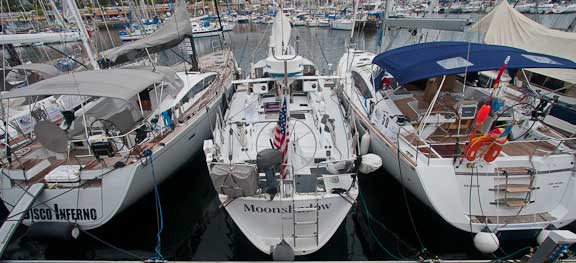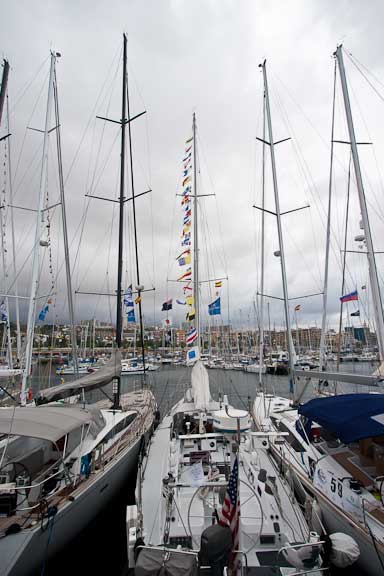
Seeing Moonshadow ensconced between two broad beamed production yachts got us to thinking. She is a few feet longer than either of her neighbors, significantly less beamy, with a rig one quarter or more shorter. Which configuration do you suppose is quicker, or would you rather sail short-handed across the ocean?

Take a look at the photo of the rigs. Moonshadow looks like we forgot to add the upper mast panel.
We don’t want to get ahead of the ARC crossing results, but when you compare her times to the rest of the cruising yachts, and think of her rig, you are going to be puzzled.
The answer is simple. Herewith are the basics of cruising yacht efficiency. To begin with, beam equals drag and has a negative impact on steering. For a given performance level, the fatter the boat the taller the rig. As the rig goes up so does the vertical center of gravity, so you need to add lead and draft to the keel.
The taller rig looks cool, but at best, can only offset the extra drag that come with beam. Can you handle these bigger sails efficiently, short handed? Probably not.
The beamier boat, with its larger and heavier rig, extra rigging, and hull surface, area weighs more for the same factors of safety. So it requires a larger engine, which is… heavier and take more fuel (lots more in fact). The bigger engine and its larger tanks for a constant range eat up interior volume. Of course there is a larger diameter prop shaft, the strut has to be longer and beefier, and the prop is bigger.
All of which leads to yet a bigger rig. You can see the design spiral here.
So why have a fat boat in the first place? Good question. The boats laying alongside Moonshadow are probably three feet wider. What do you get in return for the drag? If the interior is kept simple, you will have more visual space. But if you fill this with extra lockers – which always happens – the visual space remains the same as Moonshadow’s 14.5′ beam. And she has those four feet of extra length in which to put interior or storage.
As drag goes down with reduced beam less rig is required (which makes for a more easily handled vessel), draft can be reduced, and the boat steers more easily. And in a breeze you are going to be quicker.
What drives designs in this fashion are charter needs and owners who want lots of guest accommodations. The beam, carried aft, creates two large aft cabins. We have no argument with this concept, if that is what you want. But if you are cruising as a couple, with occasional guests, you are paying a very high price for those cabins which are being used mainly for storage.
Want proof it works this way? Watch the daily runs and the differences between Moonshadow and her beamy neighbors.

November 17th, 2010 at 7:04 am
Steve,
On top of all the design logic which is wonderful…I detect the flow of competitive juices 🙂
Do you have a web address where progress can be tracked?
thanks
November 17th, 2010 at 1:18 pm
Hi Scott:
Competitive? Us? All the boats are fitted with trackers and updates will be at http://www.worldcruising.com/arc/viewer.aspx
In the next day or so we’ll have an update on things in this regard.
November 17th, 2010 at 7:17 am
I think that people often forget (not you, those looking for tall rigs) about the leverage produced when power is applied so high above the hull. Though it is an entirely different class of boat, (size and purpose) I crew on an Evelyn 32. The hull is 25 years old and the design even older. None the less it can hold its own with designs much newer and its rig (When it had a rig…it was dropped in October…oops) looks obscenely small in the yard.
I will admit a second advantage to the small right, when I show up at a strange club and I’m looking for the boat from afar I just look for the shortest non frac rig.
I love your work! Cheers.
Robert
November 17th, 2010 at 10:42 am
Steve,
I happen to entirely agree with your design philosophy, but you did fail to mention significant aspects of the comparison.
1- Form stability: Beamy boats can carry more sail area for a given ballast weight and draft. When you include a modern carbon mast, a wide beam design will be significantly faster than a narrow boat of the same waterline length. One need only look at the history of development in Open 60’s to see the proof on the water. Even with the use of canting keels and extreme draft, no narrow hull designs can compete.
2- Heel angle: The narrow boat will sail at significantly greater angles of heel, certainly a negative factor in comfort. On the other hand the flat bottom sections of the wide boat will pound your fillings out.
3- Unbalanced hull lines: The broad stern hull form becomes asymetrical as it heels, is less directionally stable, and makes the autopilot work much harder.
4- Righting moment, safety: In the extreme case, very wide boats can even fail to self-right. Your narrower, balanced hull form is inherently safer in extreme conditions, whether running off or hove to.
I’ve delivered wide deck salon boats like the Jeanneau’s docked alongside Moonshadow,and personally wouldn’t take one as a gift. Crossing a 16′ wide living room with a wet, varnished cabin sole and no hand-holds while in the Gulf Stream roller coaster is slightly more dangerous than soloing the Eiger north face.
So which type of boat will make a faster Atlantic crossing when sailed by a couple? My money is on the 25 year old Moonshadow for sure!
November 17th, 2010 at 11:27 am
Hello RDE:
Good comments on design. However, the extreme shapes of the Open 60s are driven by their rule. The stability aspects drive the search for power. Take out that and the 60′ LOA and the Open 60s would be longer, narrower with smaller rigs.